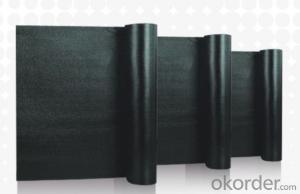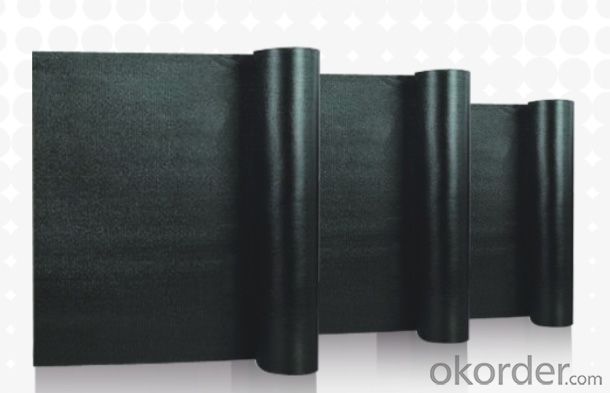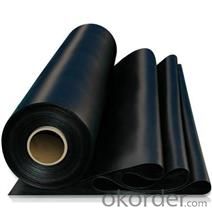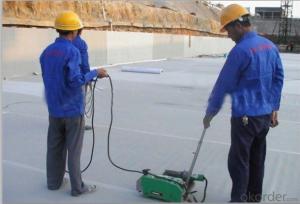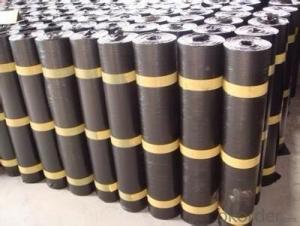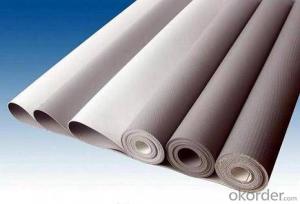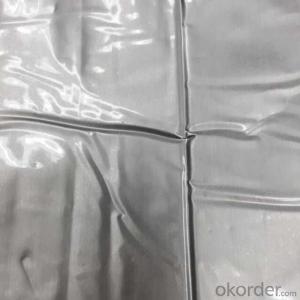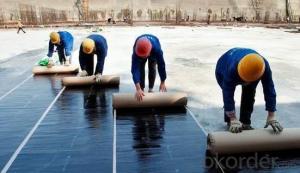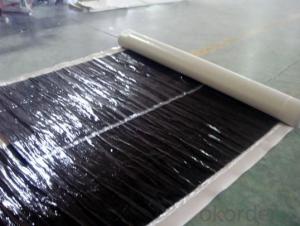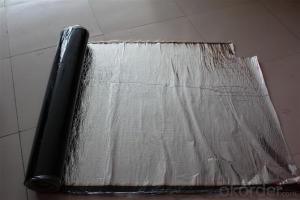Self Adhesive Modified Bituminous Waterproofing Membrane
- Loading Port:
- China main port
- Payment Terms:
- TT OR LC
- Min Order Qty:
- 5000 m²
- Supply Capability:
- 100000 m²/month
OKorder Service Pledge
OKorder Financial Service
You Might Also Like
Description
itis a modified bitumen base sheet consisting of polymer modified asphalt added viscosifier inside covering with different upper separated materials and underside with silicone antisticking layer. According to different upper surface, it includes three types: PE film surfacing (SAM-930APE), sand surfacing (SAM-930AS) and antisticking surfacing (SAM-930AN). There have two kinds of thickness: 3.0 mm and 4.0 mm.
Item | Requirement | ||
Soluble matter content, g/m 2 ≥ | 3 mm | 2100 | |
4 mm | 2900 | ||
Tensile property | Tensile strength, N/50mm ≥ | 3 mm | 600 |
4 mm | 800 | ||
Elongation at the maximum tensile force, % ≥ | 40 | ||
Resistance to heat( degree centigrade ) | 70, No sliding, flowing, dripping | ||
Flexibility at low temperature,( degree centigrade ) | -30 | ||
No cracking | |||
Water tightness | Pass at 0.3 MPa, 120 min | ||
Sheering properties N/50mm | Between membranes ≥ | 1.0 | |
Between membrane and aluminum plate ≥ | 1.5 | ||
Shank watertight | Pass | ||
Immersed in oil, pieces ≤ | 2 | ||
Holding Power/ min ≥ | 15 | ||
Thermal ageing | Elongation at the maximum tensile force, % | 40 | |
Flexibility at low temperature,( degree centigrade ) | -28 | ||
No cracking | |||
Sheering properties between membrane and aluminum plate, N/mm | 1.5 | ||
Dimension stability, % ≤ | 1.0 | ||
Self-adhesive bitumen re-peel strength, N/mm ≥ | 1.5 | ||
Surface Preparation
Surfaces should be dry, clean, smooth and free from any dusts, oil or loose particles. Cracks and uneven places need to be filled by polymer mortar.
Priming
Before membrane laying, substrate treating agent need to be brushed evenly and completely cover all laying places.
Membrane laying
After substrate treating agent drying, lay SAM-930A material according to application designs.
Sealing, fixing and constraining on vertical surfaces
On vertical surfaces, fix with metal battens and seal with sealants for membranes.
FAQ
1. Is sample available before place orders?
A: Yes, sample is ok.
2. How long is the dispatch period?
A: It will be around 20-30 days.
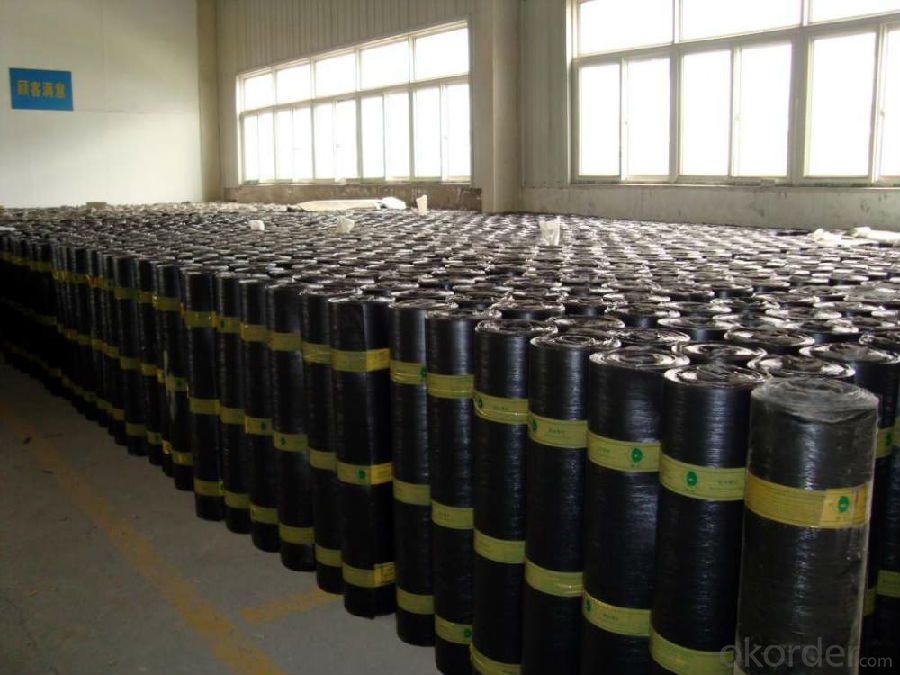
- Q: Can a waterproofing membrane be used in swimming pools or other water features?
- Certainly, swimming pools or other water features can indeed utilize a waterproofing membrane. In fact, it is highly advisable to employ such a membrane in these areas to avert water leakage and potential harm. By serving as a barrier between the water and the surrounding structures, a waterproofing membrane ensures that the water remains contained within the pool or water feature. Not only does it prevent water seepage, which can inflict structural damage and necessitate expensive repairs, but it also safeguards the pool or water feature from the harsh chemicals employed for water treatment, thereby guaranteeing its durability and long lifespan. Consequently, the utilization of a waterproofing membrane is an essential measure in the construction or renovation of swimming pools or other water features, guaranteeing their functionality and longevity.
- Q: Can a waterproofing membrane be used in cold climates?
- Yes, a waterproofing membrane can be used in cold climates. In fact, it is highly recommended to use a waterproofing membrane in cold climates to protect structures from moisture damage caused by snow, ice, and freezing temperatures. Waterproofing membranes are designed to be flexible and durable, allowing them to withstand extreme temperature fluctuations without cracking or deteriorating. They create a barrier that prevents water from seeping into the structure, which is crucial in cold climates where water can freeze and expand, causing significant damage to buildings and infrastructure. Additionally, some waterproofing membranes are specifically formulated to perform well in cold weather conditions, offering enhanced resistance to freeze-thaw cycles and ensuring long-term protection against water infiltration. Therefore, it is essential to use a quality waterproofing membrane in cold climates to maintain the integrity and longevity of structures.
- Q: How are waterproofing membranes installed?
- Waterproofing membranes are typically installed by first preparing the surface to ensure it is clean and free of any debris. Then, the membrane is unrolled and cut to size, ensuring it covers the entire area that needs to be waterproofed. Next, the membrane is adhered to the surface using a specialized adhesive or heat welding, depending on the type of membrane being used. Finally, any seams or joints are properly sealed to ensure a watertight installation.
- Q: Is a waterproofing membrane resistant to root penetration?
- Yes, a waterproofing membrane is typically resistant to root penetration.
- Q: Can waterproofing membranes be used on green roofs?
- Yes, waterproofing membranes can be used on green roofs. In fact, they are an essential component of green roof systems as they prevent water leakage and protect the underlying structure. Waterproofing membranes are specifically designed to withstand the unique challenges posed by green roofs, such as water infiltration and root penetration, ensuring the longevity and effectiveness of the green roof system.
- Q: Can a waterproofing membrane be used on concrete tanks?
- Yes, a waterproofing membrane can be used on concrete tanks. A waterproofing membrane is designed to provide a barrier against water penetration and can be applied to various surfaces, including concrete. Concrete tanks, such as those used for water storage or containment, can benefit from the use of a waterproofing membrane to prevent water leakage or seepage. The membrane is applied to the concrete surface, creating a protective layer that prevents water from entering or exiting the tank. This can help to maintain the structural integrity of the tank and prevent any potential damage or contamination caused by water leakage. Additionally, waterproofing membranes can also provide protection against other substances, such as chemicals or pollutants, that may be present in the tank. It is important to choose the appropriate type of membrane for the specific requirements of the concrete tank and to follow the manufacturer's instructions for application to ensure effective and long-lasting waterproofing.
- Q: Can a waterproofing membrane be applied to tiled surfaces?
- Certainly! A tiled surface can indeed receive the application of a waterproofing membrane. In reality, it is customary to utilize a waterproofing membrane beneath tiled surfaces, particularly in regions susceptible to moisture like bathrooms, showers, and kitchen backsplashes. The waterproofing membrane serves as a shield, thwarting water infiltration into the foundation, thereby safeguarding both the tiles and the underlying structure against water-related harm. Before applying the waterproofing membrane for best outcomes, it is crucial to ensure that the tiled surface is adequately prepared and devoid of any fissures or impairments.
- Q: Can a waterproofing membrane be used in conjunction with a drainage system?
- Using a waterproofing membrane alongside a drainage system is indeed a viable option. In fact, it is frequently advised to employ both simultaneously to achieve optimal waterproofing and drainage results in spaces like basements, roofs, and foundations. The waterproofing membrane serves as a shield against water infiltration, while the drainage system effectively eliminates any surplus water build-up. Through the integration of these two systems, a comprehensive solution is guaranteed to safeguard the structure against potential water-related harm.
- Q: Can a waterproofing membrane be used on elevator pits?
- Yes, a waterproofing membrane can be used on elevator pits. Elevator pits are vulnerable to water damage due to their location below ground level and the potential for water infiltration. Installing a waterproofing membrane in the elevator pit can help protect the structure from water damage and prevent issues such as corrosion, mold growth, and deterioration. The membrane acts as a barrier, preventing water from seeping into the pit and causing damage to the elevator equipment or the surrounding structure. It is important to select a waterproofing membrane specifically designed for below-grade applications and to ensure proper installation to achieve effective waterproofing in elevator pits.
- Q: Can a waterproofing membrane be used in historic buildings?
- Indeed, it is possible to utilize a waterproofing membrane in historic buildings. Given their age and construction materials, historic buildings frequently encounter challenges associated with moisture infiltration and water damage. To address this, waterproofing membranes offer a prevalent solution that prevents water seepage and safeguards the structural integrity of the building. Nonetheless, it is crucial to select a waterproofing membrane that is compatible with the materials and construction methods employed in the historic building to guarantee its preservation and adherence to historical authenticity. Moreover, any waterproofing work undertaken on a historic building should be carried out by professionals possessing expertise in historic preservation. This ensures proper installation and minimizes any adverse impact on the building's historical value.
Send your message to us
Self Adhesive Modified Bituminous Waterproofing Membrane
- Loading Port:
- China main port
- Payment Terms:
- TT OR LC
- Min Order Qty:
- 5000 m²
- Supply Capability:
- 100000 m²/month
OKorder Service Pledge
OKorder Financial Service
Similar products
Hot products
Hot Searches
Related keywords

